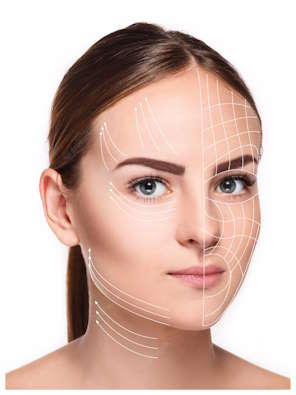Welcome to the enthralling journey through the history of thread lifts in cosmetic treatments! This non-surgical facelift technique has seen remarkable developments over the years, reshaping the landscape of anti-aging treatments. In this article, we will delve into the origins of thread lifts, their early challenges, and the innovative advancements that have made them a popular choice for those seeking a rejuvenated appearance without treatments. Let’s embark on this captivating voyage and explore the fascinating history of thread lifts!
The Genesis of Thread Lifts

The roots of thread lifts can be traced back to the late 1990s when pioneering cosmetic surgeons were seeking alternatives to traditional facelifts. Traditional facelifts involved treatments, which meant extended downtime and potential risks associated with invasive procedures. The idea was simple yet ingenious – use biocompatible threads to lift and tighten sagging skin, providing a more youthful appearance without the need for treatments.
The concept of thread lifts was not entirely new. Dermatologists and plastic surgeons had been using surgical sutures for decades to close wounds and promote healing. The concept of using threads as a lifting mechanism sparked interest among cosmetic surgeons, who saw the potential for a non-surgical facelift that could deliver natural-looking results.
Early Challenges and Experimentation
In the early days, thread lifts were an experimental procedure with mixed outcomes. Surgeons used non-absorbable sutures made from materials like nylon or polypropylene for the first thread lift procedures. These sutures provided an initial lifting effect, but they posed long-term risks, such as inflammation and extrusion.
Furthermore, early thread lifts had limitations in their ability to lift sagging skin effectively. The threads lacked the necessary anchoring mechanisms to achieve consistent and long-lasting results. As a result, patients experienced varying degrees of success with the procedure, leading to some skepticism within the medical community.
Advancements in Thread Materials
Despite the initial challenges, the concept of thread lifts intrigued cosmetic surgeons, leading to continued experimentation and research. One significant advancement came in the form of absorbable sutures, which addressed some of the concerns associated with non-absorbable threads.
Absorbable sutures made of materials like polydioxanone (PDO) showed promising results. PDO threads could be naturally absorbed by the body over time, eliminating the need for removal and reducing the risk of adverse reactions. PDO threads were also biocompatible, further enhancing their safety profile and effectiveness.
Thread Lift Techniques Evolve
As cosmetic surgeons gained more experience with thread lifts, they refined their techniques to achieve better results. The early thread lift procedures were relatively straightforward, involving the insertion of threads under the skin to provide a lifting effect.
To improve the lifting capabilities of thread lifts, surgeons introduced the concept of barbed threads. Barbed threads had tiny, bi-directional barbs along their length, allowing for better anchoring of the threads to the underlying tissues. This innovation provided a more significant and sustained lifting effect, addressing some of the limitations of early thread lift procedures.
Thread Lifts Gain Popularity
As thread lift techniques and materials continued to improve, the popularity of this non-surgical facelift soared. Patients were drawn to the minimal downtime and natural-looking results offered by thread lifts. Additionally, the non-invasive nature of the procedure appealed to those who were hesitant about undergoing treatments.
The word-of-mouth buzz about the impressive outcomes achieved with thread lifts further contributed to their rising popularity. As more individuals sought non-surgical solutions for their aging concerns, thread lifts became a sought-after option in the world of cosmetic treatments.
Thread Lifts Beyond the Face
The success of thread lifts in addressing facial sagging and wrinkles opened the door to their application in other areas of the body. Surgeons explored using thread lifts for neck lifts, brow lifts, and body contouring, expanding the possibilities for patients seeking non-invasive cosmetic enhancements.
Thread lifts were found to be effective in addressing sagging skin and providing subtle lifting effects in various body regions. This versatility further solidified thread lifts’ position as a multifaceted anti-aging treatment, attracting a diverse range of patients seeking tailored solutions.
Refining Thread Lift Techniques

As thread lifts gained popularity, skilled cosmetic surgeons continued to refine their techniques. This ongoing evolution in thread lift procedures allowed for more personalized treatments, addressing individual patients’ unique concerns and goals.
Surgeons learned to tailor thread lift treatments based on patients’ facial anatomy, skin condition, and desired outcomes. The ability to customize thread lift procedures ensured that each patient received a personalized treatment plan, contributing to the natural and harmonious results thread lifts are known for.
The Modern Thread Lift Experience
Today, thread lifts have established themselves as a popular and effective anti-aging treatment option, providing patients with a non-surgical solution for their aesthetic concerns. The modern thread lift experience is marked by advanced techniques, improved thread materials, and a personalized approach to treatment.
Personalized Consultations: The thread lift journey begins with a thorough consultation with a skilled and experienced cosmetic surgeon. During this consultation, the surgeon assesses the patient’s facial anatomy, skin condition, and desired outcomes. Based on this evaluation, a personalized thread lift treatment plan is created to meet the patient’s unique needs.
Thread Material Options: With the advancement in thread materials, patients now have a range of options to choose from. PDO threads remain a popular choice due to their biocompatibility and collagen-stimulating properties. Other thread materials, such as polycaprolactone (PCL) threads, offer longer-lasting effects, making them suitable for certain individuals seeking extended results.
Barbed Threads and Techniques: Barbed threads continue to be a prominent feature of modern thread lift procedures. The bi-directional barbs provide better anchoring and lifting capabilities, delivering immediate and sustained results. In addition to traditional barbed threads, newer variations, like spiral threads, offer enhanced lift and support in specific areas.
Combination Treatments: The versatility of thread lifts allows for seamless integration with other cosmetic treatments. Many patients choose to combine thread lifts with dermal fillers, Botox, or laser treatments to achieve comprehensive facial rejuvenation. This combination approach ensures that each aspect of the aging process is addressed, resulting in a natural and harmonious outcome.
Minimal Downtime: One of the primary appeals of thread lifts is the minimal downtime associated with the procedure. Most patients can resume their daily activities shortly after the treatment, with only mild swelling and bruising that typically resolves within a few days. This convenience makes thread lifts an attractive option for those with busy schedules.
Advancements on the Horizon
As we peer into the future of thread lifts, the possibilities for innovation and refinement are truly exciting. Ongoing research and development within the field of cosmetic treatments are likely to bring further advancements to thread lift procedures.
Thread Materials of the Future: As technology continues to progress, we can expect to see even more advanced thread materials with enhanced properties. Future thread materials may offer prolonged collagen-stimulating effects, leading to longer-lasting results and potentially reducing the need for repeat treatments.
Customized Thread Designs: As we gain a deeper understanding of facial anatomy and tissue dynamics, thread designs may become more tailored to specific facial regions. Customized thread designs could provide even more precise and targeted lifting effects, resulting in natural contours and improved overall facial harmony.
Non-Facial Applications: While thread lifts have already expanded beyond the face, the future may hold even more possibilities for their application in other areas of the body. Advancements in thread technology could pave the way for non-surgical body contouring options, offering patients further opportunities for personalized rejuvenation.
Nonsurgical Neck Lifts: One area of interest in thread lift development is nonsurgical neck lifts. As the neck is a common area of concern for aging, creating effective and long-lasting non-surgical solutions for neck rejuvenation remains a priority for cosmetic surgeons.
Minimalistic Incisions: As techniques continue to evolve, future thread lift procedures may involve even smaller and more discreet incisions. Minimizing incision size can further reduce downtime and scarring, making thread lifts an even more attractive option for individuals seeking subtle yet impactful results.
Conclusion:
The journey through the history and evolution of thread lifts in cosmetic treatments has been a thrilling exploration of innovation and progress. From their humble beginnings to their prominent role in modern aesthetic medicine, thread lifts have reshaped the way we approach anti-aging treatments.
With the refinement of thread lift techniques, the introduction of barbed threads, and the development of advanced thread materials, patients can now enjoy natural-looking results and minimal downtime. The future of thread lifts holds even greater potential for innovation, with the promise of customized treatments and extended rejuvenation.
As technology and expertise continue to advance, thread lifts are poised to play an increasingly pivotal role in providing patients with personalized and effective solutions for their aesthetic needs. Whether it’s restoring facial contours, lifting sagging skin, or enhancing overall facial harmony, thread lifts are sure to continue captivating the world of cosmetic treatments for years to come.
